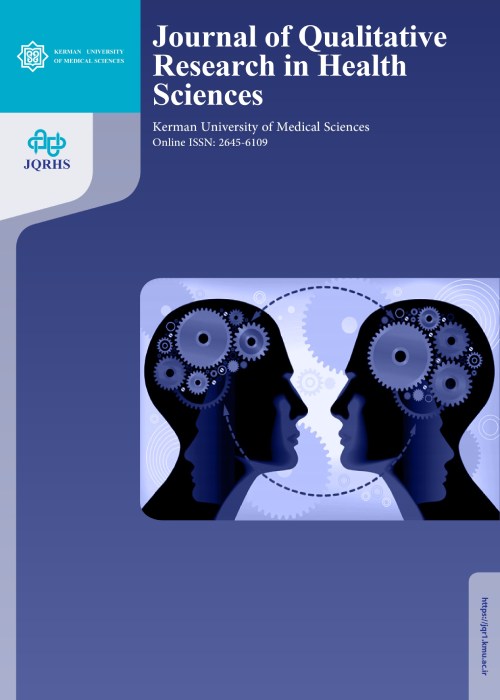فهرست مطالب

Journal of Qualitative Research in Health Sciences
Volume:10 Issue: 2, Summer 2021
- تاریخ انتشار: 1400/04/19
- تعداد عناوین: 8
-
-
Pages 65-74Introduction
The family is an integral part of the health care team. Focusing on family-centered care in neonatal intensive care units (NICUs) involves using strategies to support families by supporting parental involvement in NICUs. Accordingly, the present study aimed to examine the strategic elements of family-centered care in NICUs.
MethodsThe present study was conducted using conventional qualitative content analysis based on Graneheim and Lundman’s approach and purposive sampling. This study was conducted in NICUs of Isfahan hospitals in 2018. The data were collected through unstructured face-to-face interviews with 15 participants including parents and NICU staff. The collected data were encoded and analyzed through Microsoft Word Office and OneNote 2010.
ResultsThe analysis of the data revealed 3 main themes and 7 subthemes related to the strategic elements of family-centered care. The extracted themes (and subthemes) were: (1) Family and care (family involvement in the care process, the interaction between the medical staff and the family), (2) Parental characteristics in care (the mother as the core element of care, the father’s role in care), (3) Family needs (the need of the family for information, the importance of family preparation, the family’s need for spiritual support).
ConclusionThe present study revealed the key elements of the structure of family-centered care from the perspective of families and medical staff. The findings of this study also highlighted the role of the family in caring for patients and meeting their needs. Accordingly, measures should be taken to improve the quality of family-centered care by taking into account the strengths of this strategy.
Keywords: Family-centered care, Neonatal intensive care unit, Parents, Qualitative study -
Pages 75-82Introduction
The phenomenon of cohabitation or what is known in Iran as “white marriage” has presented women with new psychological and social challenges. The present study aimed to address the lived experience of cohabiting women.
MethodsThis qualitative and descriptive study was conducted using a phenomenological approach. The participants were 17 women who were selected through purposive sampling from among those who referred to health centers in District 22 of Tehran in 2018. The data were collected using semi-structured interviews with the participants and were saturated after 17 interviews. The collected data were analyzed using Colaizzi’s seven-step method.
ResultsThe women’s psychological and emotional needs were classified into three main themes including “experiencing a relationship with a partner with fear and hope”, “satisfaction of emotional, psychological, and sexual needs” and “concerns about an uncertain future”.
ConclusionThe main motivation for the women to be involved in this relationship was their disinterest in accepting responsibility. They also considered this relationship as a way to satisfy their sexual needs. Following these results, family and marriage counselors should take into account the serious harm that such relationships will have on the lives of future women.
Keywords: Cohabitation, Lived experience, Women, qualitative research -
Pages 83-91Introduction
One of the rare situations that occur at the consciousness level to those who are on the brink of death is a near-death experience (NDE). This experience that contains cognitive, emotional, and psychological elements is associated with profound and relatively present study aimed to investigate and explain the effects of NDEs on the lives of NDErs.
MethodsThis qualitative study was conducted using a descriptive phenomenological approach. The participants were 18 people from different cities in Iran who had NDEs. They were selected through purposive sampling from 2017 to 2019. The data were collected via individual tape-recorded in-depth interviews and simultaneously analyzed using Colaizzi’s seven-step analysis method.
ResultsThe analysis of the data revealed 216 codes that were classified under 11 thematic codes. In the next step, the extracted codes were further subcategorized under 4 main themes including social aftereffects, religious-spiritual aftereffects, emotional and psychic aftereffects, and the acquisition of transcendental abilities.
ConclusionNDEs have extensive and long-lasting aftereffects on the individual and social life of NDErs. These changes cause numerous problems for NDErs in their personal life or social relationships. Insight into these changes can positively affect NDErs and other people who interact with them.
Keywords: Near-Death Experience (NDE), Aftereffects, Life Changes, qualitative research -
Pages 92-99Introduction
Family is the most appropriate place to meet human needs and the best place to support human security and psychological well-being. Accordingly, young people should be encouraged to get married as soon as they meet the requirements for marriage. They also should be trained on how to strengthen their family life. For this reason, the present qualitative study aimed to develop a family model based on the theory of planned behavior to explain family stability.
MethodsThe data analysis method was a rule-guided qualitative content analysis. The data were collected by conducting interviews with 19 family therapists and experts in Yazd Province in 2018. The participants were selected through purposive sampling. The questions asked in the semi-structured interviews were developed based on the theory of planned behavior dealing with issues including behavioral intention, attitudes, subjective norms, and behavioral control. The interviews continued to the data saturation point when no new information or themes were observed in the data. Then the transcripts of the interviews were typed and the related themes were extracted and coded. After coding the data, qualitative research experts were asked to determine the content validity of the codes and their related categories. Then, based on the extracted categories, a local model was developed.
ResultsBased on the data analysis, 4 main themes (behavioral intention, attitudes, subjective norms, and behavioral control) and 8 sub-themes (self-control, patience, luxury-seeking, self-esteem, parenting, need satisfaction, positive attitudes toward marriage, and attainment of peace) were extracted.
ConclusionSince the family is the best emotional, social, and psychological shelter for its members, this study developed a model that can be valuable for educating families who have different problems. The developed model can also be used by family therapists and professionals dealing with family issues.
Keywords: Theory of Planned Behavior, Family Stability, Qualitative study -
Pages 100-107Introduction
An appropriate and applicable model of hospital performance assessment can potentially lead to accountability, quality of service, and patient satisfaction. The purpose of this study was to identify the effective factors on hospital performance assessment.
MethodsIn this qualitative study, in order to elucidate the experts’ experiences of hospital performance assessment, based on purposive sampling, individual semi-structured interviews were conducted with 27 health services management professors, university and hospital managers, national accreditors, and the authorities in charge of quality improvement of hospitals in Mazandaran Province. Interviews were recorded, transcribed, codified, classified, and analyzed based on the conventional content analysis approach.
ResultsThe participants’ experiences indicated the need to take into account all dimensions influencing performance assessment as well as a balanced measurement of the structure, process, outcome, control, and context of the hospital that provides services. Totally, 5 main themes and 18 sub-themes were extracted from the data analysis.
ConclusionThe results of this study indicated that a comprehensive performance assessment system needs to measure all dimensions of hospital performance. It is therefore recommended that in hospital performance assessment, in addition to traditional attention paid to resources and facilities, hospital processes, the outcomes of proper implementation of processes, control, and the context in which the hospital provides services also be taken into account.
Keywords: Assessment, Performance assessment, Hospital, Qualitative content analysis -
Pages 108-114Introduction
Domestic/family violence including child abuse, spousal abuse, elder abuse, and parental abuse is a common issue in the modern world. Adolescent-to-mother abuse is one of the phenomena that have been the focus of attention in recent decades due to its negative effects on the family system. The objective of the present study was to investigate the lived experiences of mothers abused by their adolescent children and to determine its final structure by surveying the research participants.
MethodsThis study employed a qualitative and phenomenological method. Nine participants were selected using the purposive sampling method and in-depth interviews were conducted until data saturation. The interviews were recorded and transcribed and then analyzed using a descriptive phenomenological psychological method.
ResultsData analysis revealed 11 components of mothers abuse by their adolescent children including: 1) Physical injury, 2) Emotional abuse; 3) Financial pressure, 4) The sense of being emotionally harmed, 5) Perception of child’s behavior as an abusive interaction, 6) Spiritual harm, 7) Pathology, 8) Causality of abusive behavior; 9) Ambivalent perception of abusive behavior, 10) Cyclical nature of child-mother abusive interaction patterns, and 11) Intentionality of abusive behavior.
ConclusionThe results of this study showed that the depth of harms to mothers abused by their adolescent children can be very extensive and severe. The insights from this study provide many contributions to counseling centers and family therapists.
Keywords: Parental abuse, Abused mothers, Phenomenology -
Pages 115-123IntroductionPain management is especially important for infants who are not able to verbally express their pain. The objective of this study was to promote pain management in Neonatal Intensive Care Unit (NICU).MethodsThe present study was conducted using an action research based on Kemmis and McTaggart’s action research cycle on 35 participants including nurses, physicians, and center managers involved in the care of neonates. Four qualitative methods including interviews, focus group discussions, strategic meetings, and field notes were used for data collection. The content analysis approach was also used to analyze the data. Two action cycles were designed, with four stages of “identification, planning, implementation, and observation and reflection”.ResultsBased on the results of this study, the source of the challenges was categorized into four areas of human resources management, pain control policy, workplace conditions, and management factors. The steps for the follow-up and implementation of the proposed solutions and strategies included training workshops, preparation of pain control policy, provision of facilities and equipment, and participation of senior managers in the implementation of neonatal pain management. The results of data analysis in the final evaluation revealed two themes of “comfort” and “improvement” in pain management in the NICU.ConclusionThe results of this study showed positive experiences of the participants on implementation of pain management in the NICU. The results also demonstrated that pain management problems in NICU can be reduced, without imposing high costs, by forming multidisciplinary teams and engaging various disciplines in the process of neonatal pain management.Keywords: Pain management, neonate, NICU, Qualitative study
-
Pages 124-133IntroductionImproving the quality of clinical education requires a continuous review of the status quo, recognition of strengths and weaknesses, as well as correction of these weaknesses. Besides, the experiences of ICU students can be useful in removing such weaknesses. The objective of the present study was to investigate the personal experiences of nursing students about the characteristics of an effective clinical instructor and to explain the concept of “effective instructor” in clinical education.MethodsThis qualitative study was conducted based on van Manen’s phenomenology. Using purposive sampling, 12 nursing students working in the intensive care unit of Qazvin University of Medical Sciences were selected and studied. The data were collected by conducting in-depth semi-structured interviews. All interviews were recorded and then the related codes and themes were extracted using van Manen’s analysis method. The validity and robustness of the study were obtained through attention to the four axes of validity, trustworthiness, reliability, and generalizability.ResultsThe transcripts of the interviews were analyzed and conceptual codes were extracted. After analyzing the data, 12 categories, 51 subcategories, and 5 themes were extracted. The extracted themes included scientific and practical competence, communicator and clinical coordinator, professional behavior guide, theoretical-clinical mediator, and fair evaluator.ConclusionBased on the findings, the participants in this study emphasized the key role of the instructor in creating a suitable context for professionalization. They acknowledged that an instructor with good personality traits, speaking skills, management, appropriate clinical competencies, effective professional communication, and a realistic evaluation can train qualified students to work in the country’s healthcare system.Keywords: Clinical education, Effective instructor, Phenomenological Study


